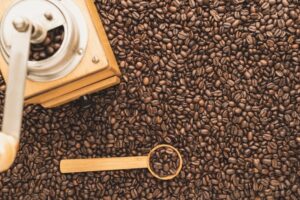Kona coffee is a specialty coffee that requires special attention to yield high-quality beans. It features a laborious and expensive manufacturing process and eventually, farmers are required to package it in costly jute bags for overseas transportation. So, why is Kona coffee so expensive?
Contents
Why Is Kona Coffee So Expensive?
Kona coffee is so expensive because it is only grown in the small Kona Coffee Belt region in Hawaii and is handpicked by farmers, further increasing the cost of labor. The high business, production, and packaging costs also contribute to the high price.
With fewer high-end Kona coffee trees, there is limited supply in the market, and so the high demand makes the prices hike. The following factors also contribute to the high price of Kona coffee.

High Cost of Labor
The main reason why Kona coffee is expensive is the labor cost. Every coffee bean is handpicked. Farmers only pick the red cherries from the same tree several times during the picking season.
Typically, picking Kona coffee costs 75 to 85 cents per pound, while automated picking of other coffee types costs 3 cents per pound.
Also, unlike other countries, Kona coffee is 100% American, and workers get minimum wages that are considerably higher than the wages that are allowed in other countries, making the overall price high.
Single Origin
Kona coffee grows in the Kona Coffee Belt region along the slopes of the volcanoes of Hualalai and Mauna Loa on the big island of Hawaii. The region is small as it measures 30 miles long and 1 mile wide.
The high altitude at which the plants grow is around 3,000 feet above sea level, giving the coffee a desirable mild taste. Given the area’s unique climatic conditions, the single-origin Kona coffee faces no competition, which leads to price hikes.
Availability
Considering that Kona coffee grows in a small piece of land, there is a limited amount produced per year, around 1% of the world’s coffee production. Additionally, its taste profile is light, sweet, fruity, and has slight hints of spice and nuts, increasing its demand.
With fewer coffee trees and the fact that many want to drink this coffee, it’s clear that the price might be slightly high. Unfortunately, many coffee plants die of agricultural diseases such as coffee berry borer and leaf rust leaving fewer coffee plants to satisfy the world’s demands for Kona coffee.
The limited supply has caused companies in different regions to blend 90% random coffee and 10% Kona. However, the Kona Coffee Belt region does not interfere with the coffee quality resulting in higher prices.
General Belief
Apart from the high costs of production and demand, there is an overrated belief in the high quality and high price of Kona coffee. With this belief, the marketers and advertisers tend to take advantage and keep the prices of Kona coffee high.
Detailed Roasting and Processing
After handpicking Kona coffee, the processing is an extensive process. You can either wet or dry the coffee beans. Wet processing is putting the coffee beans in a tank full of water. This allows the defective beans to float to the top.

Wet processing leaves the Kona coffee beans with a cleaner and less tasty flavor. On the other hand, dry processing generates coffee with a strong fruity flavor because you leave the coffee beans out in the sun to dry. After processing, you roast the coffee, giving it much flavor.
Roasting is a science that requires you to know when to start, stop and cool the Kona coffee beans without affecting the taste and quality of the coffee. The skills and expertise in Kona coffee roasting also add to the price.
High Packaging Costs
Packaging is crucial as it helps maintain the freshness of Kona coffee and keeps them free from spoilage or rotting before reaching its destination. Failure to pack and seal them properly might lead to insects or rodents damaging them. These coffee beans are prone to damage from moisture.
A jute bag is ideal for transporting Kona coffee for overseas consumption. Jute material is a natural vegetable fiber made from the outer skin and stem of a jute plant. When manufacturing jute bags, you immerse the stem in slow-running water and scrape off the non-fibrous material.
The manufacturing process is laborious and time-consuming. The end product is a high-quality jute bag that can safeguard your Kona coffee throughout the entire journey. The costly packaging adds to the expense of coffee.
High Costs of Production
In most cases, farmers purchase Kona coffee plants as seedlings to make sure they plant the healthiest and most suitable plants. It takes three to four years for a Kona coffee tree to produce sufficient cherry for commercial purposes.
However, there is only one harvest per year which lasts for two to three months as the cherries ripen. The time-consuming growing process and waiting for the cherries to be ready for harvest makes the farmers sell the cherries at high prices.
Additionally, the coffee plants need fertilizer and annual pruning to eliminate the unproductive branches for optimal growth. Farmers also need to protect them from weeds and pests infestation. All these expenses add to the high price of Kona coffee.
Taxes
Tax charges on Kona coffee vary from the grocery store, restaurant, and state to state. Depending on the state you live in, enjoying a cup of coffee in a high-class café or purchasing a bag of coffee in a grocery store may lead to you paying taxes on that particular coffee.
Kona Coffee Recipes
Although Kona Coffee is expensive, it’s definitely cheaper than Kopi Luwak and it’s versatile, and you can use it to prepare a wide range of recipes such as:
Espresso
Brewing with a manual or electric espresso machine:
- Measure and grind the coffee beans – Use the finest settings on your grinder to get fine fine grounds for your espresso. A single espresso shot requires 8 grams of coffee grounds and around 15 grams for a double shot.
- Clean the portafilter
- Using your finger distribute the grounds in the portafilter
- Tamp down your shot evenly and consistently, a tamper helps in restricting the flow of water, which also ensures even extraction
- Without the portafilter in place, run the machine for 5 seconds to clear the ground head
- Insert the portafilter and start brewing immediately to avoid burning the surface of your coffee
- Brew for about 25 to 30 seconds to avoid under-extraction or over-extraction
- Serve the coffee while hot

Pour Over Kona Coffee
- Boil water to 205 F
- Add one tablespoon of medium ground Kona coffee beans in a pour-over coffee pot
- Place a filter, and in a steady and slow-motion, pour one cup of hot water
- Remove the filter and enjoy your cup of coffee
Health Benefits of Kona Coffee
Although Kona coffee is costly, it is uniquely delicious and has vital minerals and antioxidants. Furthermore, drinking Kona coffee has the following health benefits.
Helps Reduce Stress
The sweet aroma that Kona coffee produces gives you a relaxing feeling that helps relieve stress and depression. This is because the caffeine content in this coffee activates the neurotransmitters that regulate moods, such as serotonin and dopamine.
Minimizes the Risk of Type II Diabetes
Type II diabetes is a disease that prevents the body from utilizing insulin as it should do. Consuming Kona coffee reduces the risk of Type II diabetes as it contains vital minerals and antioxidants that help the body to utilize insulin effectively, lowering the risks of this disease.
Improves Brain Function
People who consume Kona coffee regularly have a higher IQ and cognitive ability. Kona coffee contains a high caffeine content that promotes CNS stimulation, boosting brain function. Caffeine blocks adenosine, a neurotransmitter in the brain that promotes sleep, enabling you to remain alert for longer.
Additionally, it increases the resting brain entropy. High levels of brain entropy are essential to the way the brain functions as it results in higher information processing capabilities. An increase in brain function also supports the overall health of all the organs in the body.
Prevents Cancer
Drinking about two to three cups of Kona coffee every day reduces the risk of colon cancer. On the other hand, it decreases the risk of developing aggressive prostate cancer in men and postmenopausal breast cancer.
Also, Kona coffee contains polyphenols that help decrease the inflammation that could be responsible for some cancerous tumors.
Boosts Metabolism
Coffee contains caffeine, popularly known for reducing fatigue and boosting energy levels. The cultivation and roasting process of Kona coffee increases the caffeine content.
Caffeine blocks adenosine receptors, increasing the levels of other neurotransmitters in the brain that regulate your energy levels.
Helps Weight Loss
The caffeine in Kona coffee alters fat storage and improves gut health, both of which are beneficial for weight management. After breaking down body fat, caffeine turns it into fuel that improves your physical performance.
Promotes Teeth Health
Kona coffee has natural antibacterial properties that help prevent dental decay and cavities. However, this depends on how often you drink your coffee. Additionally, you will only enjoy the natural benefits when you drink your coffee black without adding milk or creamers.

If you drink three to four cups of coffee every day, ensure you maintain good oral hygiene. The acid in coffee softens and breaks down the enamel. The enamel acts as a protective barrier for your teeth, so you are at risk of bacterial damage and tooth decay when it breaks down.
Offers Vital Nutrients and Antioxidants
Brewed Kona coffee has essential nutrients and antioxidants such as Vitamins B2, B3, and B5, magnesium, potassium, and manganese. Magnesium helps in building strong teeth and bones, potassium reduces blood pressure and prevents osteoporosis and kidney stones.
Manganese is an essential nutrient that ensures the normal functioning of the nervous system and the brain. Antioxidants such as flavonoids prevent the development of diabetes, cardiovascular disease, and cognitive diseases such as dementia and Alzheimer’s.
Promotes a Healthy Skin
Apart from boosting your energy levels and providing you with antioxidants, Kona coffee comes with visible and noticeable health benefits such as improved skin health.
Typically, it contains an antiseptic extract that helps treat abrasions, cuts, snake bites, and dry skin. It also helps in reducing the appearance of cellulite on the skin.
Related Questions
How Long Does Kona Coffee Last After Roasting?
As long as you keep it in a cool and dry place, Kona coffee is safe for drinking up to six months after roasting. However, it won’t taste as good when stored for long.
Can I Freeze Kona Coffee?
It is advisable to freeze Kona coffee beans in a vacuum-sealed bag if you want to store them for later use and when it’s time to brew your Kona coffee, ensure you first bring them to room temperature before brewing.
Keep in mind that higher temperatures are great enemies of Kona coffee’s freshness as they result in more rapid oxidation.
How Do I Tell That My Kona Coffee Has Gone Bad?
If Kona coffee has gone bad, it loses its pleasant aroma and smells a bit moldy, rancid, or mildewy. Drinking it causes no harm however it does not have much flavor.
Final Thoughts
So, why is Kona coffee so expensive? Kona coffee is expensive due to the high production cost, high business cost, and high demand. Despite its high cost, it has many health benefits, such as boosting energy levels and reducing cancer risks.



